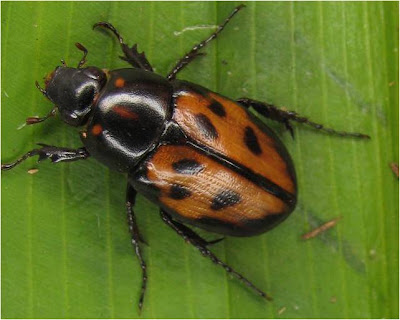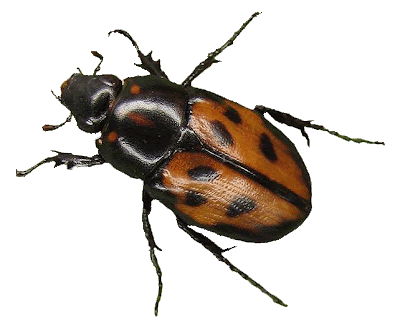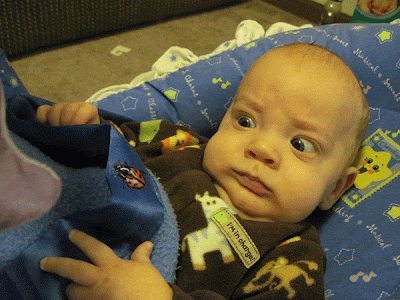Wednesday, March 31, 2010
Research Topic
For my project I plan to map out the “character states” of each of the 15 genera in the scarab beetle tribe Cyclocephalini (Coleoptera: Scarabaeidae: Dynastinae). This is a crucial step in my Master’s thesis research. To do this, I will need to examine beetles under the microscope and look at many characters (i.e. shape of legs or hair on wing cover) and assign a number to each state that character may exhibit (i.e. 0 for no spines, 1 for one spine, 2 for three spines or 0 for no hair, 1 for short hair, 2 for long hair). This data will be organized, using a program called Mesquite. During the time period remaining, I won’t be able to have a complete analysis, but I should be able to present some of the preliminary work.
Manipulating Images with Photoshop
Our assignment was to take an image and manipulate it in photoshop. I've never used photoshop before, but I think it's an okay first attempt. Since my research is on the tribe Cyclecephalini, I used an image of a species within this group.
Here is the original image of Cyclocephala marginalis:

First I sharpened the image and played around with a few other tweaking features. Then, I cut the image of the beetle out and made the background transparent. Here is the result:

Finally, for fun, I took an image of my son and added the beetle to it. I was trying to make him look apprehensive about it, but it only sort of works as the two images don't seem to blend very well. Still, it was fun.

Here is the original image of Cyclocephala marginalis:

First I sharpened the image and played around with a few other tweaking features. Then, I cut the image of the beetle out and made the background transparent. Here is the result:

Finally, for fun, I took an image of my son and added the beetle to it. I was trying to make him look apprehensive about it, but it only sort of works as the two images don't seem to blend very well. Still, it was fun.

Wednesday, March 3, 2010
Scientific Databases
For class we were to use a scientific database to come up with a scientific research question. Unfortunately, good biological databases lacking at this time. As for as I am aware, there is nothing even close to the level of the geology database, GeoMapApp, we used in class. This lack of biological databases is a problem that my adviser is currently working to solve and is one of the projects I am trying to help with. It's called The Biofinity Project. It will be a repository of biodiversity data and be an invaluable tool to biodiversity research. However, it is not yet available (hopefully within the next couple of months it will be).
Back to the task at hand. The database I did use is called Global Biodiversity Information Facility (GBIF), but it is far from complete in my area of interest. I looked up the distribution data for the beetle Cyclocephala amazona to be suprised by the results. According to my information on C. amazona it occurs from Costa Rica south to Paraguay and Chile (Ratcliffe and Cave 2006), yet GBIF shows records for Panama north to Southern Mexico and even has a record in the U.S. Ratcliffe and Cave said that all specimens labeled C. amazona that they examined from areas north of their distribution turned out to be C. multiplex. All of these GBIF specimens need to be reexamined to determined whether they really are C. Amazona or whether they are the very similar looking C. multiplex.
Therefore:
1) Problem: These data do not conform with the most recent publications regarding species distribution and need to be reexamined.
2) Data available: 817 specimens from the Instituto Nacional de Biodiversidad (Costa Rica), 6 specimens from the University of Kansas Biodiversity Research Center, and 299 specimens from the Texas A&M University Insect Collection.
3) Data limitation: Specimen data from only these three institutions have been submitted to GBIF.
Reference
Ratcliffe, B. C., and R. D. Cave. 2006. The dynastine scarab beetles (Coleoptera: Scarabaeidae) of Honduras, Nicaragua, and El Salvador. Bulletin of the University of Nebraska State Museum 21:1-424.
Back to the task at hand. The database I did use is called Global Biodiversity Information Facility (GBIF), but it is far from complete in my area of interest. I looked up the distribution data for the beetle Cyclocephala amazona to be suprised by the results. According to my information on C. amazona it occurs from Costa Rica south to Paraguay and Chile (Ratcliffe and Cave 2006), yet GBIF shows records for Panama north to Southern Mexico and even has a record in the U.S. Ratcliffe and Cave said that all specimens labeled C. amazona that they examined from areas north of their distribution turned out to be C. multiplex. All of these GBIF specimens need to be reexamined to determined whether they really are C. Amazona or whether they are the very similar looking C. multiplex.
Therefore:
1) Problem: These data do not conform with the most recent publications regarding species distribution and need to be reexamined.
2) Data available: 817 specimens from the Instituto Nacional de Biodiversidad (Costa Rica), 6 specimens from the University of Kansas Biodiversity Research Center, and 299 specimens from the Texas A&M University Insect Collection.
3) Data limitation: Specimen data from only these three institutions have been submitted to GBIF.
Reference
Ratcliffe, B. C., and R. D. Cave. 2006. The dynastine scarab beetles (Coleoptera: Scarabaeidae) of Honduras, Nicaragua, and El Salvador. Bulletin of the University of Nebraska State Museum 21:1-424.
Subscribe to:
Comments (Atom)
